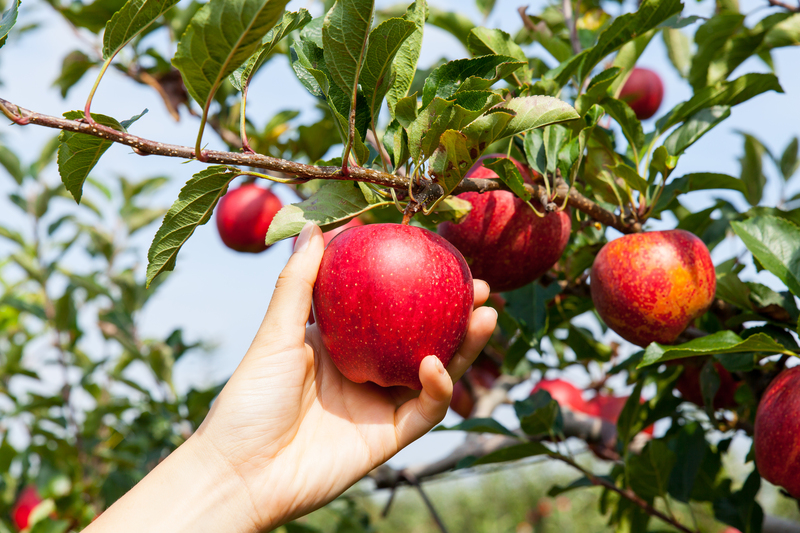Vertical Gardening and Its Economic Benefits
Posted on 28/05/2025
Vertical Gardening and Its Economic Benefits: A Comprehensive Guide
Vertical gardening is transforming the way we approach agriculture, landscaping, and home gardening. With urban spaces becoming increasingly limited and food security a pressing concern, innovative gardening methods such as vertical gardens have gained prominence. But beyond their aesthetic and environmental advantages, vertical gardening systems are also crucial from an economic standpoint. This article explores the concept, types, and the extensive economic benefits of vertical gardening, offering readers a thorough understanding of why this trend is making waves globally.
Table of Contents
- What is Vertical Gardening?
- Types of Vertical Gardening Systems
- Main Keyword Variations and Their Usefulness
- Economic Benefits of Vertical Gardening
- Environmental and Social Implications
- Conclusion
- Frequently Asked Questions
What is Vertical Gardening?
Vertical gardening involves growing plants vertically, stacking layers of vegetation, or using walls and other upright supports instead of traditional horizontal beds. These gardens can be established indoors or outdoors, on walls, fences, balconies, and rooftops. This innovative gardening technique allows for efficient use of available space, making gardening accessible even in small urban environments.
Key Features of Vertical Gardening
- Space Efficiency: Utilizes vertical, instead of horizontal, real estate.
- Versatility: Supports a wide range of plants, including vegetables, flowers, and herbs.
- Adaptability: Suitable for both small apartments and large commercial buildings.
- Accessibility: Brings gardening opportunities to people without traditional garden space.
Types of Vertical Gardening Systems
Vertical gardens come in various forms, each designed to maximize space, water use, and sunlight. Here are the most common types:
1. Living Walls (Green Walls)
- Pre-planted panels or felt systems attached to vertical surfaces.
- Include integrated irrigation systems for automated watering.
- Popular in office buildings, apartments, and public spaces.
2. Vertical Planters and Pots
- Stacked pots or planters arranged in columns or mounted on walls.
- Ideal for home gardeners, offering flexibility and customization.
3. Hydroponic and Aeroponic Towers
- Utilize soilless growing mediums and nutrient solutions.
- Enable year-round, high-yield production with minimal resource use.
- Common in commercial vertical farms producing leafy greens and herbs.
4. Trellises and Climbing Structures
- Traditional method for supporting climbing vegetables and flowering vines.
- Simple to construct and maintain for both decorative and edible gardens.
Main Keyword Variations and Their Usefulness
- Vertical Gardening - Most commonly used, appeals to general queries.
- Vertical Garden Systems - Targets those searching for infrastructure or setups.
- Economic Benefits of Vertical Gardens - Focuses on the financial advantages of this gardening practice.
- Vertical Farming - More commercial and large-scale, often overlaps with urban agriculture.
- Living Wall Benefits - Appeals to both environmental and economic interests.
- Urban Vertical Farms - Focused on city-based or rooftop gardens for sustained produce.
Using a mix of these keywords naturally within content ensures SEO optimization and draws in a broader audience searching for information on this topic.
Economic Benefits of Vertical Gardening
Adopting vertical gardening systems offers a plethora of economic benefits for individuals, businesses, and entire communities. Below we explore how a vertical garden isn't just good for the environment or personal wellness, but is also potentially a game-changer for your finances.
1. Cost Savings for Households
One of the primary economic advantages of vertical gardening is the reduction in grocery bills:
- Homegrown Produce: Growing your own vegetables, fruits, and herbs can significantly cut down on store-bought produce expenses.
- Seasonal Availability: Vertical gardens can extend growing seasons and support year-round crops, leading to a constant supply of fresh greens.
- Reduced Wastage: Harvest only what you need, when you need it, minimizing food waste.
- Lower Maintenance: Modern systems with automated irrigation mean less time, effort, and money spent on upkeep.
*For urban families and apartment dwellers, a small vertical garden on a balcony or kitchen wall can easily pay for itself in a single growing season by providing fresh basil, tomatoes, lettuce, and more.*
2. Profit Opportunities for Urban Farmers
Vertical farming isn't just limited to home gardeners; it's a lucrative enterprise for urban farmers and entrepreneurs:
- High Yield Per Square Meter: By utilizing vertical space, crop density increases dramatically, leading to much higher yields compared to traditional methods.
- Product Differentiation: Fresh, local, and sustainably grown produce from vertical farms commands higher prices at farmers' markets and local groceries.
- Direct to Consumer Model: Vertical gardens near urban centers can reduce distribution costs and provide same-day harvests to restaurants and households.
- Integration with Restaurants: Chefs value hyper-local, super-fresh ingredients and may partner with or purchase directly from vertical garden businesses.
- Reduced Pest and Disease Risks: The controlled environment of vertical farms lessens crop losses, improving profit margins.
Studies show that innovative vertical garden farming ventures have a notable return on investment (ROI) due to lower input costs and premium pricing for fresh, chemical-free produce.
3. Job Creation & Local Economic Growth
Vertical gardening and farming stimulate local economies by:
- Creating new roles in installation, maintenance, design, and operation of vertical systems.
- Stimulating related industries, like hydroponics supply, automation, and agriculture technology.
- Encouraging entrepreneurship among youth and urban communities.
- Revitalizing vacant lots and underused buildings, generating tax revenue and community vibrancy.
*Some cities have reported a significant number of new jobs attributed solely to the growth of vertical gardens and local farm startups.*
4. Property Value Increases
Investing in a vertical garden system can lead to:
- Enhanced Curb Appeal: Living walls beautify properties, attracting buyers or tenants willing to pay a premium.
- Improved Energy Efficiency: Green facades can insulate buildings, lower energy consumption, and attract environmentally conscious investors.
- Sustainable Certifications: Properties with sustainable solutions often qualify for green building ratings, increasing market value.
*Research by real estate professionals suggests homes and commercial properties featuring vertical gardens see their value increase by 7-15% on average.*
5. Reduced Food Miles and Associated Costs
Urban vertical gardens can provide local produce within city limits, which means:
- Lower Transportation Costs: Shorter supply chains cut down fuel usage and related expenses, leading to more competitive pricing.
- Reduced Spoilage: Fresher produce reaches consumers quicker, reducing losses from spoilage during transit.
- Less Dependence on Imports: Cities can be more food-resilient, retaining money in the local economy.
6. Lower Energy Consumption
Vertical gardens, especially living walls in urban settings, contribute to energy savings by:
- Insulation: Creating natural insulation barriers, reducing heating and cooling costs.
- Shading Buildings: Minimizing the urban heat island effect, especially in densely built environments.
- Humidity Regulation: Vegetation helps manage indoor air quality and reduces the need for air conditioning.
These indirect economic benefits often add up to significant annual savings for both individuals and city administrations.
Environmental and Social Implications
Vertical gardening offers a host of environmental benefits, which translate into long-term economic resilience:
- Improved Air Quality: Plants absorb toxins and particulates, reducing healthcare costs.
- Stormwater Management: Living walls manage runoff, decreasing municipal drainage expenses.
- Biodiversity Support: Attracts pollinators and beneficial insects, safeguarding local food supplies.
- Mental Well-being: Access to green spaces improves productivity and lowers stress, increasing human capital value.
From a policy perspective, cities investing in vertical gardens and green infrastructure can often access state grants or incentives, reducing the burden on public coffers.
Conclusion
Vertical gardening isn't simply a trend--it's a clear path forward for sustainable urban living. Whether it's maximizing small spaces, reducing grocery bills, supporting local economies, or increasing property values, the economic benefits of vertical gardening are both immediate and long-lasting. As more cities and households embrace vertical garden systems, we move toward a resilient, self-sufficient, and green future.
Frequently Asked Questions: Vertical Gardening & Economic Benefits
-
Q: Is vertical gardening expensive to set up?
A: Initial costs can vary, but many vertical gardening systems are affordable and can be scaled to fit any budget. Long-term savings on groceries and energy can offset setup costs quickly. -
Q: What crops are most profitable in vertical farms?
A: Leafy greens (like lettuce, spinach), herbs (such as basil, mint), strawberries, and microgreens are highly productive and profitable due to short growth cycles. -
Q: Can vertical gardens be used in extreme climates?
A: Yes, especially when coupled with hydroponic or controlled-environment systems, allowing for year-round cultivation regardless of external conditions. -
Q: How does vertical gardening contribute to local economies?
A: Through job creation, entrepreneurship, increased market activity, and property development, vertical gardening can revitalize neighborhoods and support community growth.
Ready to start your own vertical garden? Explore local resources, online guides, or vertical garden kits to make your space greener, more productive, and economically beneficial.



